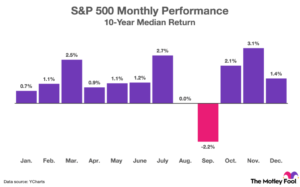Cathie Wood Thinks This Artificial Intelligence (AI) Stock Can Soar by 1,082%. Here’s Why I Think It Could Run Even Higher Than That.

2024 has been a tumultuous year for Tesla (NASDAQ: TSLA) investors.
For the first six months of the year, its shares drastically underperformed the S&P 500 and Nasdaq Composite as the stock cratered by roughly 20%. Nevertheless, longtime Tesla bull Cathie Wood of Ark Invest recently revised her price target for the EV stock. Wood is calling for Tesla shares to reach $2,600 by 2029 — 1,082% higher than its recent level.
While some investors may argue such a forecast is outlandish, I personally think Wood may be underestimating Tesla’s prospects.
Wood’s thesis hinges on robotaxis, but…
Tesla is a pioneer among electric vehicle (EV) manufacturers. After making considerable headway over the last several years, the company is now laser-focused on what it expects will be its next chapter — autonomous driving technology.
CEO Elon Musk is so compelled by the potential of autonomous driving that during the company’s latest earnings call, he said: “I recommend anyone who doesn’t believe that Tesla will solve vehicle autonomy should not hold Tesla stock. They should sell their Tesla stock. If you believe Tesla will solve autonomy, you should buy Tesla stock.”
That’s a polarizing statement, but those are pretty much par for the course with Musk. However, he isn’t the only one with a strong conviction that autonomous driving is an enormous opportunity.
In Wood’s latest model, she is projecting that subscriptions to Tesla’s autonomous driving software — dubbed full-self driving (FSD) — will be the major catalyst for the company’s future growth. In essence, FSD represents a source of high-margin recurring revenue for its EV operation.
Moreover, if the company ends up as the superior developer of self-driving technology, Tesla will have an enormous opportunity to disrupt areas such as rental car businesses, delivery services, and ride-hailing applications.
But while I understand the opportunities FSD presents, I think Wood is underestimating Tesla’s long-run potential.

…what about robotics and energy storage?
Autonomous driving is merely an extension of the EV business. But on a deeper level, FSD is an advanced application of artificial intelligence (AI). While Musk and his team remain steadfast in its FSD pursuits, Tesla has far more ambitions in the broader AI realm. In particular, it is developing a line of humanoid robots called Optimus. The idea is that it could enhance its efficiency and productivity by augmenting its human workforce with Optimus robots.
Should this effort prove successful, Tesla would have an incredibly lucrative opportunity to commercialize Optimus and sell robots to other companies. This could revolutionize the labor market — and Wood does not seem to be accounting for that potential in her model.
The main reason why Wood isn’t banking much on Optimus at the moment is that she believes commercialization of the robots is more than five years away. However, at the risk of being overly Pollyanna-ish, I think Wood may want to rethink that position. On Tesla’s second-quarter earnings call, Musk said “we expect to have several thousand Optimus robots produced and doing useful things by the end of next year in the Tesla factories.” He further predicted that in 2026 the company would be “ramping up production quite a bit” and selling them to external customers.
Beyond its AI initiatives, Tesla has already built a thriving energy storage business that I think is criminally underappreciated.
The table below breaks down the financial results for Tesla’s energy generation and storage segment over the last several quarters.
|
Category |
Q2 2023 |
Q3 2023 |
Q4 2023 |
Q1 2024 |
Q2 2024 |
|---|---|---|---|---|---|
|
Energy generation and storage revenue |
$1.5 billion |
$1.6 billion |
$1.4 billion |
$1.6 billion |
$3.0 billion |
|
Energy generation and storage gross margin |
18% |
24% |
22% |
25% |
25% |
Data source: Tesla.
Tesla has doubled its revenues from the energy storage business over the last year. But even more impressive, it has achieved strong unit economics, underpinned by a consistently expanding gross margin profile.
These dynamics are important because the growth in the energy storage segment is helping offset the stagnation and decline of its core EV business. Moreover, because it’s generating strong and growing profits from its energy generation unit, Tesla is still able to invest in important growth initiatives — particularly in AI.
Looking at Tesla’s valuation
One thing that Wall Street analysts can’t seem to agree on is Tesla’s valuation. And on the surface, I totally get it. Its market capitalization is currently around $700 billion — nearly 16 times that of Ford and 14 times the size of General Motors. Fundamentally, that doesn’t really check out.
However, like Wood and Musk, I see Tesla as much more than a car company. Investors need to look at the different components of its overall operation and analyze their valuations individually. This is commonly referred to as a sum-of-the-parts valuation.
Beyond its EV segment, the company is making inroads in two areas with strong secular tailwinds: AI and sustainable energy. Admittedly, it has yet to really monetize its AI products at scale. For that reason, I understand if bearish investors remain skeptical. But as a Tesla shareholder for many years, I have a strong belief that the company will continue making progress toward FSD. Moreover, I think success in FSD will lead to a surge of demand as the company attempts to differentiate its fleet from the competition.
In addition, I’m compelled by the case around Optimus and am aligned with Musk on the premise that these robots will be commercialized sooner rather than later. Lastly, the energy storage business is growing faster than any other part of the company, and I don’t see demand in that area slowing down anytime soon.
Whether or not the stock reaches Wood’s price target on her forecast schedule is moot. In the long run, Tesla has a lot of opportunities to disrupt several more markets other than EVs, and I am bullish about its prospects for executing on its vision. For these reasons, I think Tesla is a strong buy for investors with a long-term time horizon.
Should you invest $1,000 in Tesla right now?
Before you buy stock in Tesla, consider this:
The Motley Fool Stock Advisor analyst team just identified what they believe are the 10 best stocks for investors to buy now… and Tesla wasn’t one of them. The 10 stocks that made the cut could produce monster returns in the coming years.
Consider when Nvidia made this list on April 15, 2005… if you invested $1,000 at the time of our recommendation, you’d have $635,614!*
Stock Advisor provides investors with an easy-to-follow blueprint for success, including guidance on building a portfolio, regular updates from analysts, and two new stock picks each month. The Stock Advisor service has more than quadrupled the return of S&P 500 since 2002*.
*Stock Advisor returns as of July 29, 2024
Adam Spatacco has positions in Tesla. The Motley Fool has positions in and recommends Tesla. The Motley Fool recommends General Motors and recommends the following options: long January 2025 $25 calls on General Motors. The Motley Fool has a disclosure policy.
Cathie Wood Thinks This Artificial Intelligence (AI) Stock Can Soar by 1,082%. Here’s Why I Think It Could Run Even Higher Than That. was originally published by The Motley Fool








